Greetings readers and history-lovers!
I’m pleased to welcome you to the very first post in this new blog series about the ancient Olympics and Eagles and Dragons Publishing’s newest book, Heart of Fire – A Novel of the Ancient Olympics.
Over the next ten weeks or so, we will be looking at all aspects of the Olympic Games from their foundation and religious ceremonies, to ancient athletics, individual sports, and the actual site of ancient Olympia as it relates to the Olympiad of 396 B.C. when Heart of Fire takes place.
In this first post, we are looking at the mythological beginnings of the Olympic Games as given in three traditions.
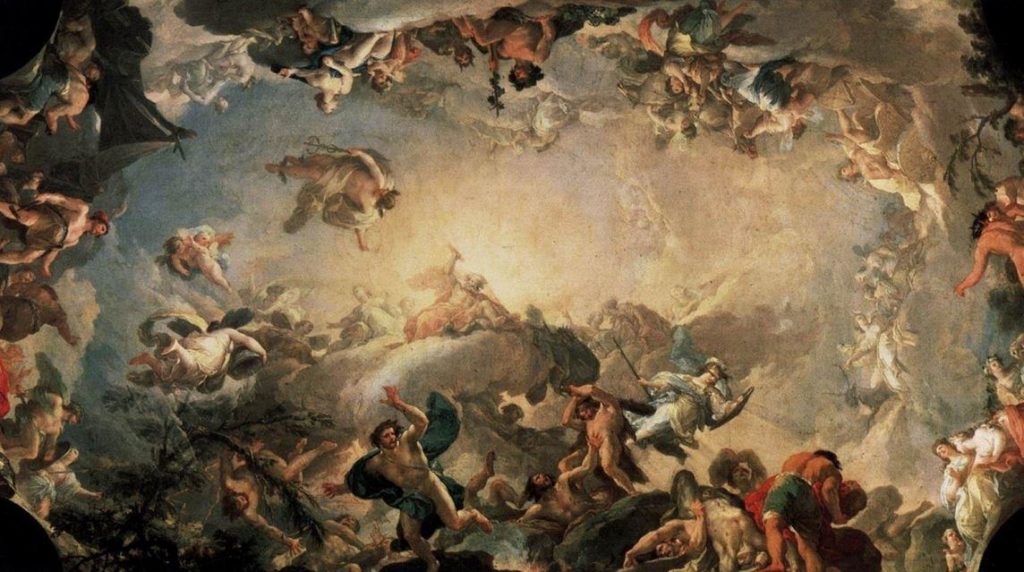
Battle between the Gods and the Titans
There are three myths related to the foundation of the Olympic Games, and the first begins with the war between the Gods and the Titans.
Ancient Olympia is dominated by an ancient hill known as the Hill of Kronos. Now, Kronos, a Titan, as we know, was the father of Zeus who, along with his siblings, waged war on Kronos and the Titans.
One of the legends associated with Olympia is that it was where Zeus wrestled with, and defeated, his titanic father. Some believe the games were established to commemorate that victory, and that the site at the base of the Hill of Kronos was where Zeus himself wrestled and defeated Kronos.
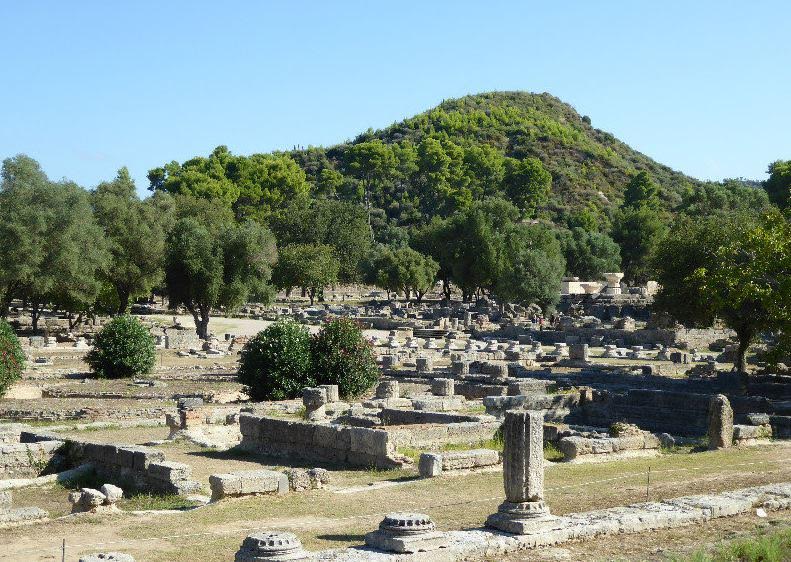
Hill of Kronos overlooking sanctuary of Olympia
Another tradition around the Olympic Games is that they were founded by Herakles in thanks to his father, Zeus, for granting him victory in war.
The great epinikion poet, Pindar, speaks of this in his Olympian Ode #10:
With the help of a god, one man can sharpen another who is born for excellence, and encourage him to tremendous achievement. Without toil only a few have attained joy, a light of life above all labors. The laws of Zeus urge me to sing of that extraordinary contest-place which Heracles founded by the ancient tomb of Pelops with its six altars, after he killed Cteatus, the flawless son of Poseidon and Eurytus too, with a will to exact from the unwilling Augeas, strong and violent, the wages for his menial labor…
…But the brave son of Zeus gathered the entire army and all the spoils together in Pisa and measured out a sacred precinct for his supreme father. He enclosed the Altis all around and marked it off in the open, and he made the encircling area a resting-place for feasting, honoring the stream of the Alpheus along with the twelve ruling gods. And he called it the Hill of Cronus; it had been nameless before, while Oenomaus was king, and it was covered with wet snow. But in this rite of first birth the Fates stood close by, and the one who alone puts genuine truth to the test, Time. Time moved forward and told the clear and precise story, how Heracles divided the gifts of war and sacrificed the finest of them, and how he established the four years’ festival with the first Olympic Games and its victories.
We will hear more about the Theban poet, Pindar, later throughout this blog series. For now, this small part of the ode mentions several things we should note. There is reference to Pelops whose tumulus was located in the middle of the Olympic sanctuary and whose story is big part of Heart of Fire.
Pindar also references one of Herakles’ labours which was to clean out the stables of King Augeas. More importantly, Pindar paints us a picture of the Olympic sanctuary and the Altis, which was marked out by Herakles as a place for rest and feasting at the base of the Hill of Kronos, and where every four years the Olympic festival was held.
At the first Olympics begun by Herakles, it is said that the gods themselves competed, with Apollo defeating Hermes in a foot race, and also defeating Ares, the God of War, in boxing.

The God Hermes running
But there is another tradition about Herakles…a different Herakles.
There were two Herakles?
Apparently so. The second was not the son of Zeus and Alcmene. He was known as Daktylos Herakles and it seems that the tradition around this second Herakles could be even older.
In the age of Kronos, when Zeus was a baby, Kronos was devouring his children (that’s a whole other story!). To keep the baby Zeus safe, his mother Rhea gave her son into the care of five Daktyloi, daimones whose duty it was to protect Zeus in a cave on Mt. Ida in Crete. To drown out the cries of the baby, the danced wildly and clashed their spears and shields together so that Kronos would not find Zeus.
Supposely, Daktylos Herakles was the leader of the five Daktyloi, who established the Olympic Games in the age of Kronos (Cronus). One of the oldest Olympic events, as we shall see in a later post, was the hoplite race in armour, and this aligns with the use of spears and shields by the five Daktyloi who were often pictured as armoured youths.
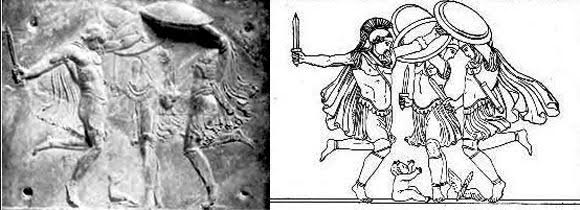
Baby Zeus and Idaean Daktyloi dancing and making noise to protect the infant Zeus
Pausanias, in his Description of Greece, touches on the Daktyloi here:
As for the Olympic Games, the most learned antiquarians of Elis say that Kronos was the first king of heaven, and that in his honour a temple was built in Olympia by the man of that age, who were named the Golden Race. When Zeus was born, Rhea entrusted the guardianship of her son to the Daktyloi of Ida, who are the same as those called Kouretes (Curetes). They came from Kretan (Cretan) Ida–Herakles (Heracles), Paionaios (Paeonaeus), Epimedes, Iasios and Idas. Herakles being the eldest, matched his brothers, as a game, in a running-race, and crowned the winner with a branch of wild olive, of which they had such a copious supply that they slept on heaps of its leaves while still green. It is said to have been introduced into Greece by Herakles from the land of the Hyperboreans, men living beyond the home of Boreas . . . Herakles of Ida, therefore, has the reputation of being the first to have held, on the occasion I mentioned, the games, and to have called them Oympiakos (the Olympics). So he established the custom of holding them every fifth year, because he and his brothers were five in number.
Now some say that Zeus wrestled here with Kronos himself for the throne, while others say that he held the games in honour of his victory over Kronos. The record of victors include Apollon, who outran Hermes and beat Ares at boxing . . .
(Pausanias, Description of Greece 5. 7. 6 – 10)
Over time, the association of Daktylos Herakles with the Games became merged with the more famous Herakles, the son of Zeus and Alcmene, whose Twelve Labours were illustrated on the frieze of the Temple of Zeus at Olympia.
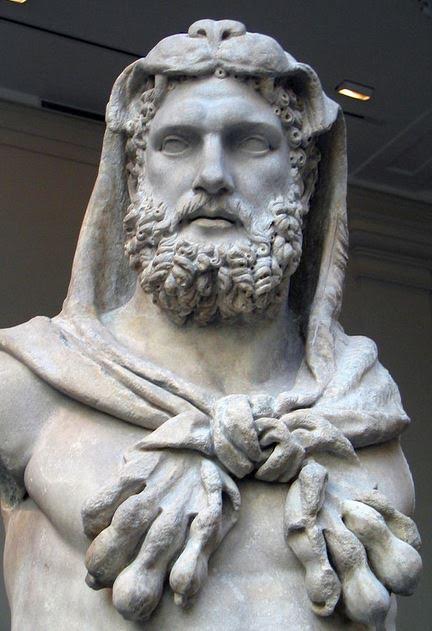
Herakles
So much for Daktylos Herakles.
There is a final myth associated with the foundation of the Olympic Games, and that is the legendary chariot race between Oinomaus, son of Ares, king of Pisa and father of Hippodameia, and the hero, Pelops, after whom the Peloponnese is named.
King Oinomaus was supposedly a cruel ‘wine-loving’ man and father who continuously slew all the suitors for his daughter Hippodameia’s hand in a chariot race from Olympia to Argos.
When Pelops, a prince from Lydia arrived to take up the challenge with the aid of some divine horses given him by Poseidon, Oinomaus’ reign of terror came to an end, and Pelops and Hippodameia were married.

Pelops and Hippodameia
Now I have really simplified the story here because we will look at it more closely in a later post. However, this particular foundation myth points to the Games as an event to commemorate Pelops’ victory.
In tandem with the Olympic Games, said to be established by Pelops in this instance, Hippodameia was said to have established the Games of Hera, the Heraia, in thanks to the goddess for granting the victory as well. You can read more about the Heraia HERE.
The chariot race was the marquee event at the Olympic Games, and central to the story of Heart of Fire, as is the tale of Pelops and Hippodameia.
There was much testament to this particular foundation myth around the Altis of Olympia as well. One of the pediments from the temple of Zeus shows Oinomaus and Pelops with their chariots, on either side of Zeus, getting ready to race.

East pediment of the temple of Zeus at Olympia showing Zeus between Oinomaus and Pelops, just before their race

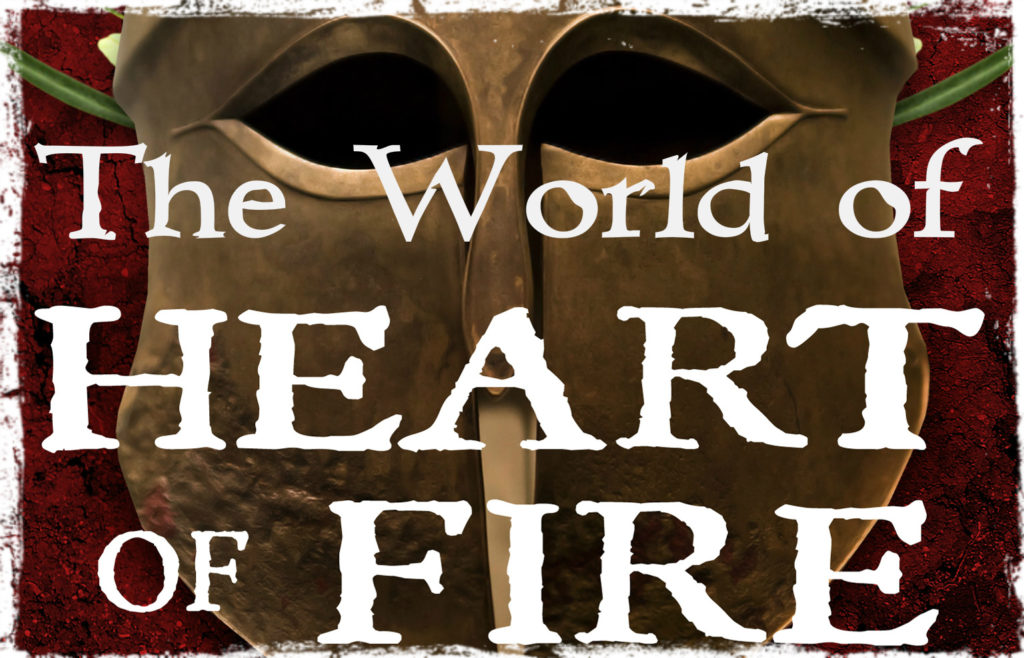
Thank you, Adam, for starting this blog on the ancient Olympics. This first installment has already inspired me and I am looking forward for those that will follow. I shall be enjoying the coming games more with this background.
You’re very welcome, Larry! I’m glad you enjoyed this one. There are so many aspects to the ancient Olympics that most of us don’t even know about, though so many enjoy the modern games. I hope the posts continue to inspire you and hold your interest 😉 Cheers, and thank you for your comment. Lots more to come!
I just finished Eagles and Dragons and I am hooked. Immediately bought the other two and look forward to devouring them.
Thank you for your kind comment, Stephen. So glad you enjoyed the book! Cheers and have a great weekend 🙂
Adam, this is so interesting! I love the story and picture of the original Herakles.
I’ve been wondering what kind of specific exercises Ancient Greeks did to prepare for battle and the Olympics. Did they do push ups? Sit ups? Crossfit ; ) I’m curious if any of the kinds of exercises we do are similar to theirs. Can you recommend any books or images that have this kind of information?
I’m looking forward to reading the next installments!
Many thanks for your comment, Zenobia 🙂 I’m very glad you enjoyed the post. The next one will be up some time tomorrow. A lot of our exercises today do indeed come from the ancient Greeks. They did lift weights, in the form of stones with carved handles. Stretching was also employed to prevent injury. I haven’t seen a form of ‘push up’ on vase paintings, but that wouldn’t surprise me in the least. The overall regimen for something like the pentathlon was a sort of circuit/crossfit training. Most of the ancient vases have pictures of athletes in the middle of performing their sport, rather than exercising. To be able to take part in the Olympics, athletes did have to meet certain requirements, including that they had been training for their sport for the previous ten months. The ‘Hellanodikai’, the judges, would not allow them to compete otherwise. So training was important at the higher echelons. I’ll be posting about boxing in particular later, as well as the importance of gymnasia and the palaestra. After a sort of warm-up and stretch, boxers were known to work the punching bags, called ‘korikoi’, and do shadow boxing, called ‘skiamachein’. In the west, it was the Greeks who created the idea of nurturing one’s body through exercise and working out so that it was not only strong and useful in battle, but also, most pleasing to look at. The idea of going to the gym for health, well-being, and looks, that is so inherent today, definitely goes back to Classical Greece. In Sparta, both boys and girls were expected to run and do strength training so that they could be the best possible citizens in the service of Sparta. There are a couple of books you could check out. The one I read some time ago and really enjoyed was Nigel Spivey’s ‘The Ancient Olympics: A History’. There is also Stephen Miller’s ‘Ancient Greek Athletics’, but I have not read that one. As far as images, if you Google something like ‘ancient Greek athlete pictures’ you’ll get a lot of images of athletes. Oftentimes, the vases and reliefs are our best sources. Hope this helps. Lots more to come on the blog! Cheers, Zenobia!